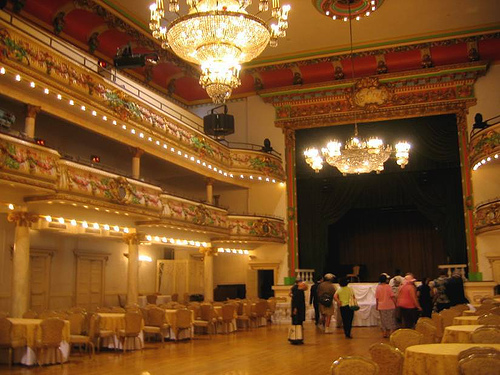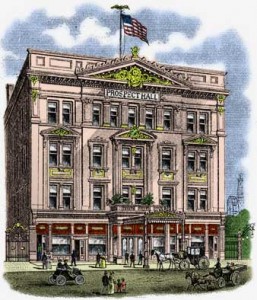Most of us know of the Grand Prospect Hall through the ubiquitous television commercials starring its current owners, Michael and Alice Halkias (“The Grand Prospect Hall – we make your dreams come true!”). Prospect Hall, as it was known until its newest incarnation, has a very special place in the history of Brooklyn and in my own life. Located on Prospect Avenue between Fifth and Sixth Avenues, it was added to the National Register of Historic Places in 1999 and originally built and owned by the German-born developer John Kolle in 1892 as a “temple of music and amusement.” Within a few years of its opening, it was destroyed in a fire in December 1900 after a Knights of Columbus event which 3,000 had attended in the ballroom. Mr. Kolle, determined to bring back an even grander hall, hired a young architect, Ulrich J. Huberty to design the new building. Huberty, along with his partner Frank J. Hemle designed the magnificent Tennis House and Boathouse in Prospect Park, among many other beautiful Brooklyn buildings.
The new Prospect Hall opened in 1902, a 140,000 square foot French Renaissance building with an exterior of light brick with limestone trim. The interior included bowling alleys (still in existence in the basement), a billiard room, a German-style oak-paneled beer hall, a shooting gallery, meeting areas, an open-air roof garden, dining rooms and a 40-foot-high ballroom. It boasted the first “French bird-cage” Otis elevator in the city – it is still there and still functions and was also the first electrified public building in Brooklyn. Many of the famous of the early part of the 20th century passed through it’s halls; William Randolph Hearst in 1906, William Jennings Bryant in 1908, Gov. Al Smith and Jimmy Walker in 1929. In the 1930s, there were Works Progress Administration theater presentations. “Scarface” Al Capone was known to frequent its Speakeasy – and also to attend opera performanc
es. Lena Horne would get her teenaged start at the Opera House in the Grand Ballroom. Other visiting luminaries are said to include Enrico Caruso, Sophie Tucker, Mae West, Sonja Henie, Bob Hope, Ginger Rogers and Fred Astaire.
At the same time, the Hall’s complex of meeting, dining and entertaining rooms were hosts to club meetings, weddings, balls anniversaries and other events. The top floor had a Masonic meeting room where there is now a ballroom that holds many ballroom dance competitions and has an incredible view of New York Harbor from its windows. The hall was home to Crescent Motion Picture Company (owned by Herman Kolle) in 1908. Movies were produced on location and shown in the open-air roof garden. The heyday of such halls is long past, though such buildings were important to the fabric of life in the early twentieth century, both for newly arrived immigrants and established society. More recently, the hall has been a set for Francis Ford Coppola’s Cotton Club, John Huston’s Prizzi’s Honor and Wes Andersons’s The Royal Tenenbaums. Many commercials have been filmed here spreads for magazines have been shot here, and performing artists like Foxy Brown and Cyndi Lauper have filmed videos here.
In 1940 the Kolle family sold the hall to a Polish group and it continued as a meeting place for unions and fraternal societies. There is evidence that the owners began selling off artwork and architectural elements in the 1960s as they tried to keep the aging hall together. By 1981, Prospect Hall was almost entirely closed off, with barrels spread throughout the building catching rainwater. Far from traditional Brooklyn centers and cut off by the Prospect Expressway, its future seemed grim. In that year, Michael and Alice Halkias fell in love with the building and bought the structure, optimistically renaming it Grand Prospect Hall.
After almost three decades and millions of dollars, the Hall is successful, exuberant and somewhat over-the-top. Though preservationists may cringe over some of the changes, the Halkias’ vision has reclaimed for us Prospect Hall. Entering the building brings us back to a more innocent, joyful time. The original spirit of the building as envisioned by John Kolle seems present, and when spying the “Welcome” over the stage in the Grand Ballroom, we indeed feel welcome in this building restored with love. The Grand Prospect Hall is probably the only existing hall which is still be used for the purposes it was originally built for. Most have either been destroyed or converted to other uses, like Acme Hall on 9th Street and 7th Avenue.
Visit the website www.grandprospect.com for more history and photos. Much of the information in this post was gleaned from theatre historian and tour guide, Cezar Del Valle. Cezar will be conducting a tour of “The Yiddish Rialto” for CUE on Sunday March 15. We hope to have a tour of “The Lost Theatres of Park Slope,” ending with a tour of The Grand Prospect Hall sometime this summer or fall. For more information, check our website at www.thecue.org or call 718-788-8500, ext. 217. And the special place Prospect Hall has in my life? My parents, Henry and Katherine, first met at a German dance at Prospect Hall in the 1920s. You might say I owe my existence to it.
(Ruth Edebohls is the Coordinator of Urban Tours at the Center for the Urban Environment. To learn more about the Center visit us at www.thecue.org.)



4 responses so far ↓
1 deborah matlack // Feb 5, 2009 at 3:53 pm
Wonderful history. I have an older friend who has celebrated many holidays at the Grand Prospect Hall, very posh indeed.
2 Bob Marvin // Feb 5, 2009 at 8:25 pm
From what I’ve read Prospect Hall in the ’30s was better known for Nazi [German-American Bund] meetings than WPA theater events. Beautiful place nevertheless and it’s unsavory past shouldn’t be held against it.
3 Brenda from Flatbush // Feb 6, 2009 at 10:28 am
Fabulous history, although it’s a shame the place had to be tarted up to be preserved. Looking forward to the CUE theatre tour.
4 Lianna from Park Slope // Mar 13, 2009 at 3:02 pm
Great recap of the hall’s history. This building has been through a lot and has finally fallen into the right hands.